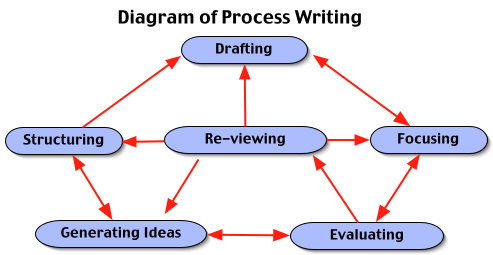 Process
Writing: Model
Process
Writing: Model Process
Writing: Model
Process
Writing: Model
The writing process, according to White and Arndt, is a cycle of generating ideas, structuring, drafting, reviewing, focusing, and evaluating (figure 1). As we can see from the directions shown by the arrows, writing is not a linear process (that is, it does not go in a straight line from start to finish), but one which involves a constant cycle of thinking, drafting, and reviewing.

Figure 1. The writing process (From: Process Writing by Ron White and Valerie Arndt, Longman, 1991.)
The many parts of this process cannot operate at the same time, even if the writer is skilled and the writing task is easy, as this would involve using more information than human short-term memory can hold. Just as a person learning to juggle does not start with a large number of objects of various sizes and shapes, so an ESL/EFL writer cannot simultaneously "juggle" all of the parts of the writing process. There are two ways of solving this problem:
1. making parts of the process automatic so they require little thought (for example, few writers think about the formation of each individual letter, although when they first learned to write they did); 2. using a range of strategies over time which allow the writer to think about each of the important parts of the composing process separately. In order to do this, outline carefully for students the skills involved in each of the stages of the composing process. These skills are best learned in the context of problem-solving writing assignments.
What is involved in each of these
sub-processes? According to White and Arndt, the following skills
must be mastered within each sub-process.
| 2. Planning/Generating Ideas | 3. Focusing | 4. Structuring | 5. Drafting | 6. Evaluating | 7. Reviewing/Revision | Printer friendly version of these seven pages
![]()